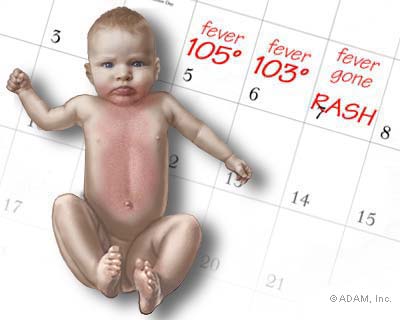Numbered Diseases of Childhood: SIXTH Disease – Roseola
This post will finish our nostalgic wanderings through the “Numbered Diseases of childhood,” which we’ve been undertaking for several weeks. We are finally at SIXTH disease.
When doctors attempted numbering the rash diseases in 1905 they were still trying to make sense of the big bundle of disease they called “measles” due to the way that they caused (mostly children) to break out in a rash during the course of their illness.
Astute clinicians began noticing different sub-groups of these so-called “measles” which they eventually separated out into: Rubella, Scarlet Fever, German Measles, Filatov-Dukes’, erythema Infectiosum and one which, even though it looked similar, had a fairly consistent startling “surprise” in it’s course.
That actually gave this last rash its name: Exanthem Subitum or “sudden rash.”
SIXTH Disease – Roseola
This is one of the three rashes whose names have caused more than a little confusion. In English, there’s Rubella, Rubeola and now Roseola – clearly different, but close enough to confuse anyone who hasn’t spent time studying the differences.
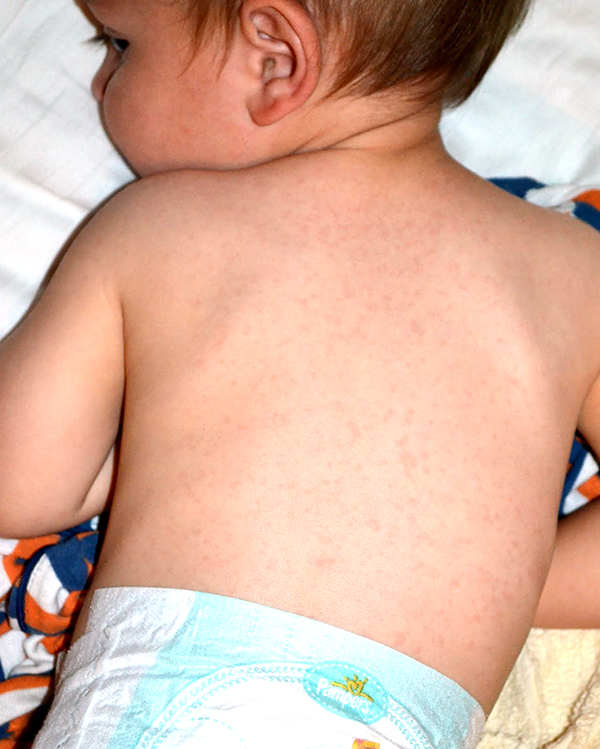 An infant with the rash of Roseola on his back.Around the world there are local names for this disease and perhaps a quick run through them will be a good start to understanding the disease.
An infant with the rash of Roseola on his back.Around the world there are local names for this disease and perhaps a quick run through them will be a good start to understanding the disease.
The terms “Roseola” and “Rose rash” may have come from the characteristic color of the rash which is usually a light rose-red. The name “Reddish Disease” I’m sure comes for the same reason.
“3-day-fever” most likely refers to the uncanny ability the disease has to produce a fairly high fever for nearly always three days – plus or minus a half-day. In fact it’s the fever which worries parents more than the rash in this disease.
“Fast Rash” and “Sudden Rash,” as we’ve said, come from the startling rapidity of the rash as it develops. Often a mother will say “I left him to go get some Tylenol and when I came back he was like this!“
“Baby Rash” and “Baby Measles” refer to how contagious this disease is. There are very few babies who make it past two years of age without contracting this illness. Perhaps this characteristic was noticed in one area who gave it the name “Wind Measles” thinking that it’s so common it must be carried on the wind.
“False Measles” and “Measles’ Brother” I’m sure deign from the fact that even though this disease causes a rash it is not the “real” measles – Rubella; or even Rubeola.
Prodrome – Contagion
Being in the 21st century we have the advantage of knowing that this disease is caused by a virus – a herpesvirus to be exact. In the same family as the “cold sore” virus but not the same virus or the same disease.
There are two forms of the virus which cause Roseola, HHV-6a and HHV-7, and we call them collectively: Roseolovirus. Studies in the US, Dubai and Japan have shown that HHV-6b infects over 90% of infants by age 2! I would classify that as almost the “poster child” of contagiousness.
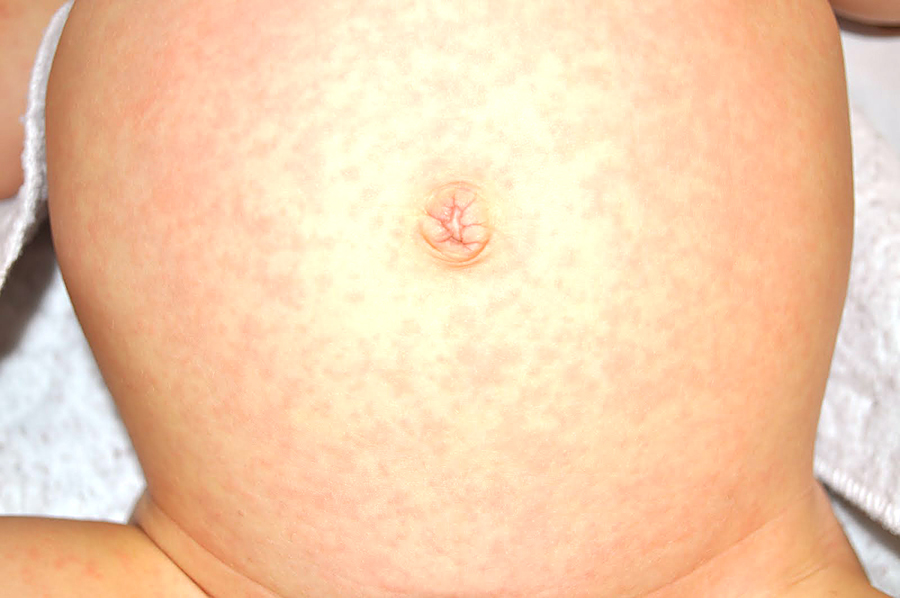 An infant with the “rose-rash” of Roseola on his abdomen.This virus has shown to be able to use “vertical transmission” meaning that the mother can transmit the virus directly to the embryo, fetus or baby during pregnancy or childbirth if she contracts the disease in her pregnancy – which is the case in 1% of births in the United States.
An infant with the “rose-rash” of Roseola on his abdomen.This virus has shown to be able to use “vertical transmission” meaning that the mother can transmit the virus directly to the embryo, fetus or baby during pregnancy or childbirth if she contracts the disease in her pregnancy – which is the case in 1% of births in the United States.
Roseola seems to be an “equal opportunity infector” by showing no preference at all to either gender or race – or even any location. And, it occurs year round, with perhaps a slightly higher incidence in the spring and fall.
Clinical Course
Although 5% of SIXTH disease cases occur in older children and adults, 95% of them occur before 3 and most between 6 and 15 months; so, lets talk about the “usual” case.
Now, after saying that, I’m going to tell you what is NOT the most common beginning to the illness; not because it doesn’t happen, it does, but because it’s so memorable that it’s the stuff urban legends are made of.
It goes like this: “A two-year-old was completely well one moment and had a seizure the next.” It lasted under a minute and the child was noted to have a rectal temperature of 103°F or more.
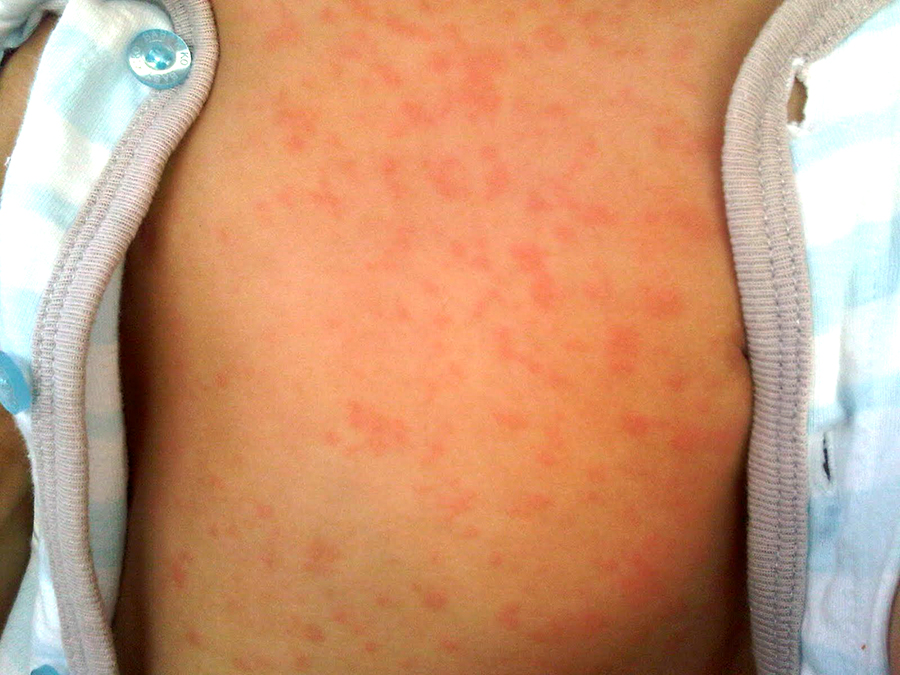 The rash of SIXTH disease, Roseola, on the abdomen of a child.After more medical work-up than was fun (or, in retrospect, was necessary) the child was diagnosed with a “febrile seizure” – meaning that the seizure wasn’t caused by any disease ONLY the temperature which shot up faster than the nervous system could cope with. All the blood work will point to a virus (which it will later be shown to be).
The rash of SIXTH disease, Roseola, on the abdomen of a child.After more medical work-up than was fun (or, in retrospect, was necessary) the child was diagnosed with a “febrile seizure” – meaning that the seizure wasn’t caused by any disease ONLY the temperature which shot up faster than the nervous system could cope with. All the blood work will point to a virus (which it will later be shown to be).
Ok, so now lets describe the USUAL course of the disease: “A two-year-old was completely well one moment and was noted to have a rectal temperature of 103° the next.” Undressing the child and using children’s acetaminophen reduced the fever so that, although a bit fussy, there were few or minor symptoms.
In fact, they appear inappropriately well for a kid whose temperature keeps peaking 103° or above every time the fever medicine wears off. There may be a bit lower appetite and perhaps a slight runny nose; and, if seen by an actual pediatrician (who knows to look for such things) a slightly enlarged, but non-tender, liver border.
After 3 – 5 days of the cat and mouse game with the fever it disappears, almost as suddenly as it came, and out pops the characteristic rash. They didn’t give it the latin name “subitum” (sudden) for nothing.
Numerous 2-3mm, rose-pink, almond-shaped, slightly-raised (or not) bumps appear on the trunk. It is not itchy and fairly rapidly spreads to the neck, face, arms and legs. They can become confluent in places.
Without fanfare, the rash merely fades away in a few hours to three days without scaling, pigmentation or even any evidence the child has been sick — except, of course, the empty Children’s Motrin bottle, bags under parents eyes and string of mommy-blog postings.
In contrast, a child suffering from FIRST, SECOND or THIRD diseases (measles, scarlet fever or rubella) would usually appear more infirm, with symptoms of conjunctivitis, coryza, cough etc., and their rashes would affect the face and last for several days.
Treatment
Being caused by a virus, there is no treatment. The fever is obviously treated symptomatically by removing clothes and coverings and with children’s Tylenol or Motrin (NOT asprin).
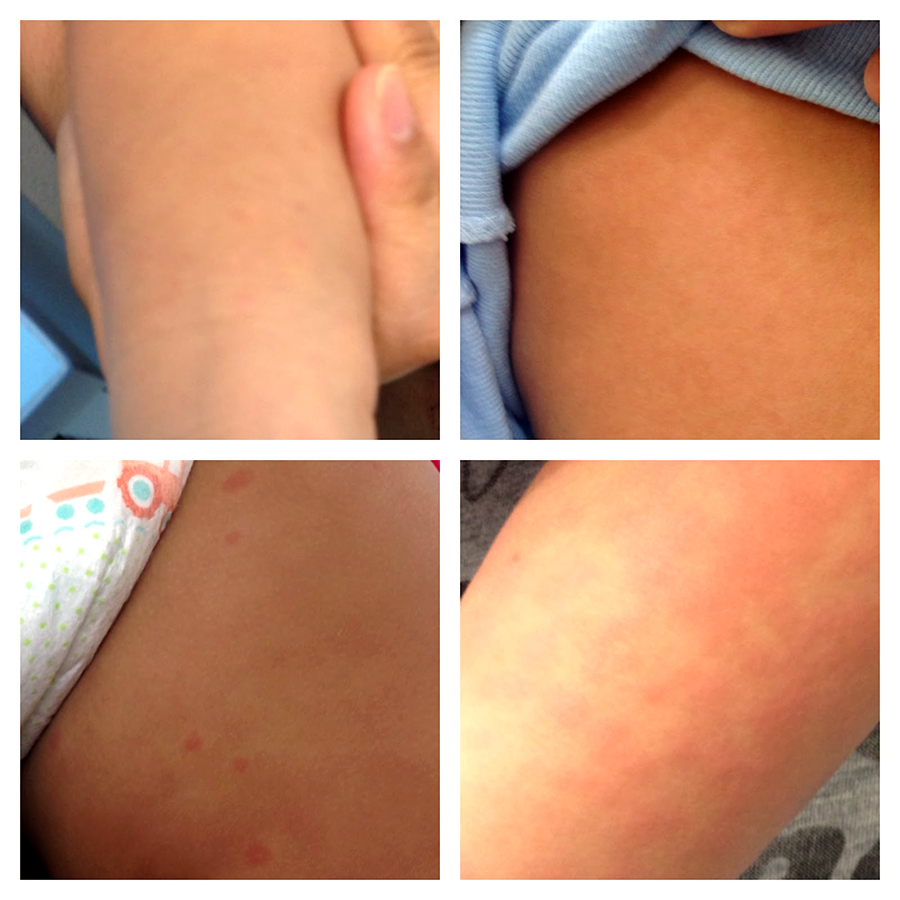 A composite of the rash of ‘exanthem subitum,’ Roseola, in a child.The method of causing fever used by the herpesvirii tends to scare the bergeebers out of parents. It’s the same way if the child gets “primary herpes stomatitis” (the very first time a child contracts a cold sore). They feel fine one minute and then develop a substantial fever quite suddenly.
A composite of the rash of ‘exanthem subitum,’ Roseola, in a child.The method of causing fever used by the herpesvirii tends to scare the bergeebers out of parents. It’s the same way if the child gets “primary herpes stomatitis” (the very first time a child contracts a cold sore). They feel fine one minute and then develop a substantial fever quite suddenly.
As you will be told, if you are unfortunate enough to end up in the ER, it’s NOT the fever itself nor even how high it goes which precipitates a “fever seizure” in children – it’s how FAST the temperature rises. And that seems to be a herpesvirus specialty.
It’s not common, but not un-common either, for a child coming down with Roseola to have a febrile seizure. Just make sure the child is on a safe surface and wait it out. It usually lasts less than a minute – and that is probably the first time you even notice they have a fever.
Complications – Sequelae
In Roseola there are almost no complications. The rare adult might reactivate with a subsequent HHV-6 infection and can show signs of mononucleosis.
The Rest of the Story
I didn’t mean this series of articles to be an exhaustive exposition of all children’s rashes, only a bit of a nostalgic tangent about the “numbered diseases of childhood.” Therefore, we are done.
It really must be said, however, that other diseases, perhaps even hundreds, can produce an exanthem as part of their presentation.
They are not part of this list because they were either discovered/identified after the practice of numbering diseases had been abandoned; or, as we had to point out to our spikey-haired, tie-less and be-sandled friend sitting in the back row of our example in the first article — they are a POX not an exanthem.
[http://www.atsu.edu/faculty/chamberlain/exanthems.htm
http://www.instamedic.co.uk/pathology/paediatrics/exanthems/index.html]
8 Posts in Numbered Diseases (numbereddiseases) Series
- Part 7 - Roseola - Sixth Disease – 27 Apr 2014
- Part 6 - Erythema Infectiosum - Fifth Disease – 15 Apr 2014
- Part 5 - Filatov-Dukes disease - Fourth Disease – 3 Apr 2014
- Part 4 - Rubella- Third Disease – 26 Mar 2014
- Part 3 - Scarlet fever - Second Disease – 18 Mar 2014
- Part 2 - Measles - First Disease – 10 Mar 2014
- Part 1 - Numbered diseases of childhood – 2 Mar 2014
- Childhood Rashes and Numbered Diseases: Intro/Index – 1 Mar 2014
Advertisement by Google
(sorry, only few pages have ads)

